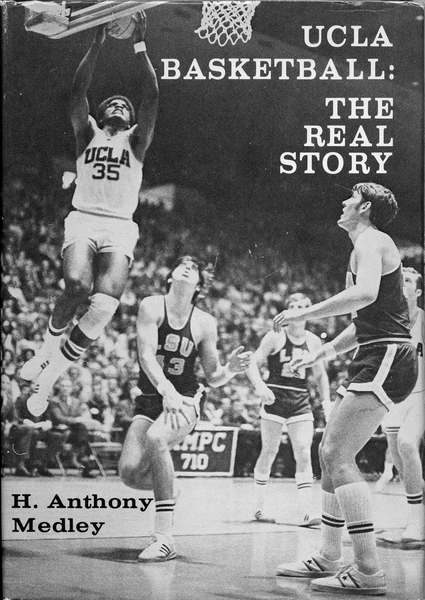|
Out of print for more than 30 years, now available for the first time as an eBook, this is the controversial story of John Wooden's first 25 years and first 8 NCAA Championships as UCLA Head Basketball Coach. This is the only book that gives a true picture of the character of John Wooden and the influence of his assistant, Jerry Norman, whose contributions Wooden ignored and tried to bury. Compiled with more than 40 hours of interviews with Coach Wooden, learn about the man behind the coach. The players tell their stories in their own words. Click the book to read the first chapter and for ordering information. Also available on Kindle. |
|
Sports Medley: Syracuse Unleashes Metaphysical Power in win over Virginia 28 Mar 16 By Tony Medley Those who cannot remember the past are condemned to repeat it: In 1988 I received a telephone call from Digger Phelps, then coach of Notre Dame’s basketball team. He told me that he used my book, UCLA Basketball: The Real Story, in the biggest victory of his career, when the Irish ended UCLA’s record 88 game winning streak in 1974, but he had loaned it to a sportswriter and it wasn’t returned and he wanted another, so I sent it to him. Now I’m going to send a copy of it to Virginia’s young basketball coach, Tony Bennett, because he clearly needs to learn from history. As explained in detail in my book, in 1963 (six years before Bennett was born) UCLA assistant basketball coach Jerry Norman went to his boss, UCLA Head Coach John Wooden, and told him that because their players were short but quick, he thought that they should install a full-court zone press to speed up the tempo by getting the other team to take quick shots, quoting master coach Pete Newell (whose California teams dominated Wooden’s UCLA teams) that “the team that controls the tempo controls the game.” Norman convinced Wooden that in an up-tempo game UCLA would always have the advantage, even if they did give up some easy baskets, and the best way to increase the tempo was to play a full court zone press the entire game, and that’s what they did. It worked, and with a team with no starter over 6-5, UCLA won 30 consecutive games without a loss and the NCAA title, UCLA’s first ever. In a key explanatory statement, Norman said that the other teams thought that the point of the press was to steal the ball, but he said that had nothing to do with it. All UCLA wanted the other team to do was to take quick shots to increase the tempo of the game. Segue to Sunday night. No. 1 seeded University of Virginia Cavaliers had played the entire season controlling the tempo, slowing the game down and beating teams with defense. With about 9:20 left in the game they had a 15 point lead over Syracuse when Syracuse put on the full-court zone press devised a half century ago by Norman. UVA broke it almost constantly, resulting in 2 on 1 fast breaks, which they clearly do not know how to run. Even though they made two baskets on the fast breaks, they only had possession of the ball for a few seconds at a time, and they also missed a few baskets and made some turnovers. After the first fast break, had Bennett been aware of the history of the game, UCLA’s zone press, and Norman’s explanation, he should have immediately called a timeout and instructed his players that after they broke the press (which they did with relative ease) they should slow it down and play their game, ignoring what looked like easy 2 on 1 fast break baskets. But he did not do that. He allowed Virginia to constantly break the press and constantly take quick shots, more than half of which they missed. The result was that Syracuse came roaring back and actually beat them by six points. Good coaching vs. bad coaching. That’s a game Virginia should never lose. But even Syracuse Coach Jim Boeheim didn’t fully understand the power his press had unleashed. The next day, he said, “Your hope in that is that you get a steal, and the secondary hope is that they make a mistake or miss a shot, and that’s what happened.” Then he said, “When we took the one point lead we stopped pressing. The reason we stopped pressing was that they were getting through our press pretty easily and getting 2 on 1s and missing. I didn’t think they were going to keep missing those 2 on 1s so we went back and contested defensively at half court and made some defensive stops.” This is stunning. Boeheim reminds me of C. S. Lewis, who said, “The last temptation is the great treason; to do the right deed for the wrong reason.” Boeheim doesn’t even begin to comprehend the powerful dynamic that his full court press unleashed! By completely changing the tempo of the game, the entire complexion of the contest changed totally. It put Syracuse on a roll. They were clearly on some sort of metaphysical high, making 9 of 10 shots, while Virginia had descended into a metaphysical low, making only 2 of 8 shots. When Boeheim got the lead and pulled the press with three minutes to go, and Virginia got back to its slow down game, the Cavaliers were totally perplexed and equally ineffective. It was palpable. For the last nine minutes of the game you could feel the force even just watching on television. It had little or nothing to do with Virginia missing shots or making turnovers. The drastic change of tempo caused by the full court press imposed mystical power on the game and the players that transcended everything. Now that I think of it, I think I’ll send Coach Boeheim a copy of my book, too.
|
|
|
